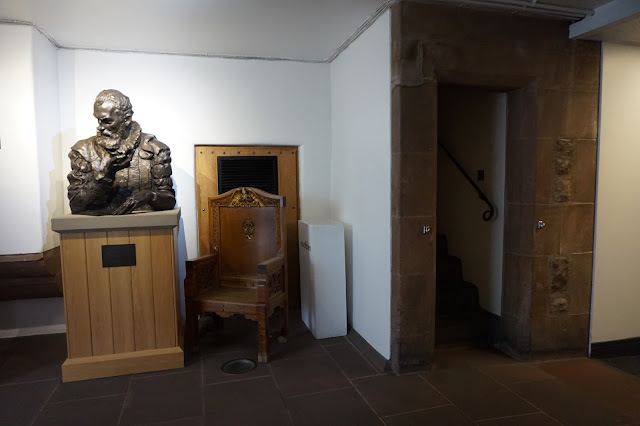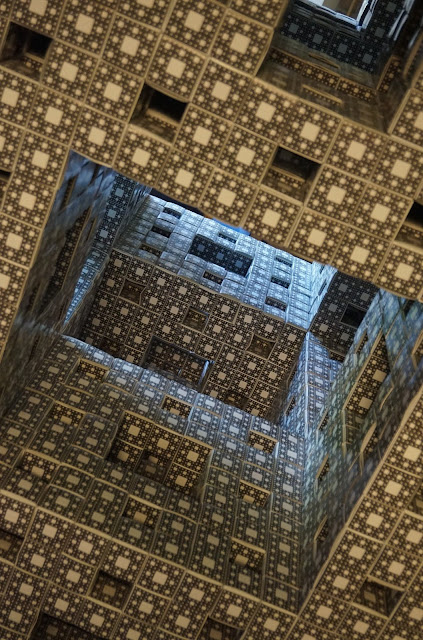John Napier lived from 1550 to 1617. He was a true Renaissance man who invented many things - from new techniques in farming to weapons of war to calculating devices. Napier's Rods (aka Napier's Bones), seen here, can be used to multiply, divide, take square roots and take cube roots. These were first described in his book Rabdology, which was published in 1617. These were used to aid in calculation for hundreds of years. The great Sir Isaac Newton (1643-1727) used these for his calculations and promoted their use. The image above is of a modern set constructed more as a beautiful curiosity (in these days of calculators and cell phones); the image below is of a set from the 1700s.

To get an idea of the size of the set above, take a look at it on display next to a cube that is the size of a standard gaming die. Note that there are multiple sets here, and that there were different forms in which they could be constructed. When electronic calculators came out, we called them "pocket calculators," these also were pocket-sized!
This other set contains rods rather than strips. In this way, each rod can display the facts for four numbers rather than just one. This set is from the late 1600s or early 1700s. It is on display at the National Museum of Scotland in Edinburgh.
The display includes other items related to Napier's life and work. Due to Napier's brilliance he was considered a sorcerer by some during his time. He was thought to have a black rooster that he used as a familiar spirit - hence the rooster in the display case. He was not a sorcerer, in fact, he was an elder in the Presbyterian church. If he were seriously considered to be a sorcerer by the powers that be, he would certainly have been executed given the time in which he lived.
Napier was born and raised in Merchiston Tower (sometimes called Merchiston Castle). Contrary to popular belief, he was not born into nobility, but his father was a wealthy land-owner who had strong connections at court, and the Napier descendants did rise to the nobility not long after John Napier's time.
Those who think Napier dabbled in the dark arts like to claim that the small round building atop the "castle" was his alchemical laboratory, but that room was actually built after John Napier's time.
Merchiston Tower was saved from ruin in the mid-1900s when it was decided to use it as the center-piece of a new technical college, Edinburgh Napier University, Merchiston Campus. Restoration work began in the late 1950s. In the photographs below, you can see how the college was built around it - a wonderful mix of old and new!
The tower is part of the college and is not a historic building that is open to the public - unlike other medieval/renaissance homes in Edinburgh such as the John Knox House or Gladstone's Land. I did get a glimpse inside, where I saw again the old and new coming together beautifully. I was glad to see this sculpture of Napier. If you look closely you can see that he is shown to be handling his calculating rods.
John Napier is the inventor of logarithms. And logarithms were used very soon after his death in the invention of the slide rule, which was used from the early 1600s until the mid-1900s. They had a nearly 350-year run as the calculating device of choice and were used by NASA to make calculations for the Apollo 11 moon landing.
As well as logarithms and Napier's Bones, Napier invented other devices with which to aid calculation. One such calculating device is known as Local Arithmetic or The Chess Board Abacus (pictured below), which he basically referred to as a "lark" and only published as basically an appendix to another work. There is at least one other device that I'm aware of, a more complicated one than others pictured in this blog, but I think only one survives and is in a museum in Madrid.
Throughout the years, mathematicians have sought to develop calculating devices. Below is one that was designed by Gottfried von Leibniz (1646-1716).
The images below were taken by me on a visit to Musee des Arts et Metiers in Paris. These are calculating devices invented by Blaise Pascal (1623-1662). He was inspired to create calculating devices due to the laborious calculations required in his father's work as a supervisor of taxation.
If it weren't for these pioneers and others like them, we wouldn't have the computers, calculators and cell phones that we have today. We owe a lot to the people of the past who were curious and inventive and hard-working. I think one of the greatest characteristics people can have is that of curiosity and then the drive to follow-up that curiosity with exploration and invention!


























































